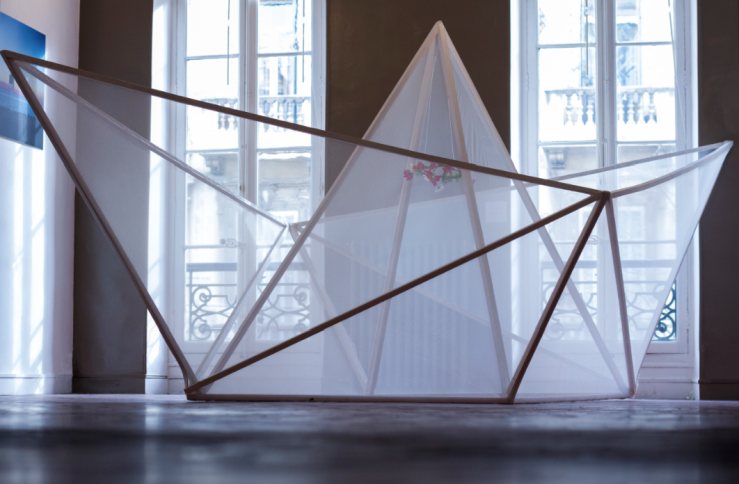
Installation, sculpture, dimensions, L.6 mx h.1,70m x l. 2 m
Marseille, 2013©Lise Couzinier
L’installation « Blanche dérive » nous questionne sur la fragilité de la vie et sur la destinée. Moyen de transport plus ou moins tangible, le bateau se veut ici fantomatique, mystérieux, telle une vespérale et intrigante présence. On pense à « l’Ile des morts » d’Arnold Böcklin et à cette barque où Charon, le passeur des âmes, conduit un défunt tout drapé de longs voiles blancs, pour son dernier voyage vers un rivage inconnu. La blancheur et la transparence de l’œuvre (corollaires au linceul mais aussi au voile de la mariée de la jeune fille) interrogent sur l’impermanence et la vulnérabilité des choses. La seule couronne de roses abandonnée dessus nous rappelle à une évanescente présence féminine : couronne d’épousée ? Couronne d’épines de jeune martyre ? Le spectateur se place face aux thèmes intimement imbriqués de l’eau, de la femme et de la mort. C’est autant ici la présence que l’absence de la femme qui est mise en scène. Les références sont foisonnantes : de la tragédie d’Ophélie de Shakespeare à la douce Ophélia de Rimbaud, des jeunes filles flottantes et spectrales des toiles de Cabanel et des préraphaélites, mais aussi la légende d’Ondine et toute la mythologie féminine aquatique, nymphes et autres sirènes.
Texte de Bérengère Chamboissier
—
White drift
The installation White drift raises questions about the fragility of life and destiny. Means of transport more or less tangible, the boat is supposed to be here ghostly, mysterious, such a vesperal and intriguing presence. One thinks about the Isle of the Dead by Arnold Böcklin and the boat where Charon, the ferryman of souls, leads a deceased draped in long white veils, for his final journey to an unknown shore. The whiteness and the transparency of the work (corollary to the shroud but also to the bridal veil of the young girl) question about the impermanence and vulnerability of things. The only wreath of roses abandoned on it reminds us of an evanescent feminine presence: a bride’s wreath? Crown of thorns of a young martyr? The viewer stands face on to the intimately interwoven themes of water, of woman and death. Here this is the presence as much as the absence of the woman which is put on stage. References are abundant: from the tragedy of Shakespeare’s Ophelia to the sweet Ophelia by Rimbaud, floating and spectral young girls from the paintings by Cabanel and the Pre-Raphaelites, but also the legend of Undine and all the aquatic feminine mythology, nymphs and other mermaids.
Translation © by Nathalie Letullier, http://www.oui-dizajn.si
